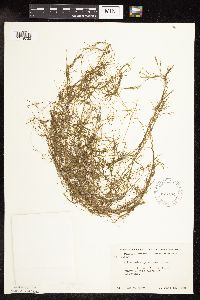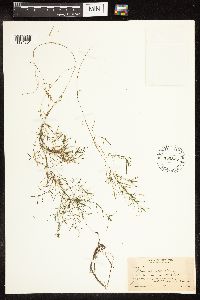Potamogeton pusillus subsp. tenuissimus
|
|
|
|
Family: Potamogetonaceae
small pondweed
[Potamogeton pusillus var. mucronatus (Fieber) Graebn., morePotamogeton pusillus var. tenuissimus Mert. & Koch] |
Leaves: stipules convolute; blade 0.9--5.4 cm ´ 0.2--2.5 mm; apex acute to obtuse, lacunae in 1--5 rows each side of midrib; veins 1--3(--5). Inflorescences: peduncles more than 3 per plant, cylindric to slightly clavate; spikes capitate to cylindric, continuous. Fruits ovoid, sides rounded, rarely concave; beak median, rarely toward adaxial edge. 2n = 26. Flowering and fruiting summer--fall. Shallow waters of lakes and streams; 0--2100 m; Alta., B.C., Man., N.B., Nfld. and Labr., N.W.T., N.S., Nunavut, Ont., P.E.I., Que., Sask., Yukon; Ala., Alaska, Ariz., Ark., Calif., Colo., Conn., Del., D.C., Fla., Ga., Idaho, Ill., Ind., Iowa, Ky., La., Maine, Md., Mass., Mich., Minn., Miss., Mont., Nev., N.H., N.J., N.Y., N.C., N.Dak., Ohio, Okla., Oreg., Pa., R.I., S.C., Vt., Va., Wash., Wis., Wyo.; Eurasia. Although Delaware and West Virginia lies within the mapped area, we know of no collections from that state. Potamogeton pusillus subsp. tenuissimus is the most common linear-leaved subspecies of the family in temperate North America. Whenever one finds a linear-leaved pondweed with 1--5 rows of lacunae on each side of the midvein, chances are that it is subsp. tenuissimus. Only Potamogeton obtusifolius could be confused with the taxon, and it can be separated by having its cylindric inflorescence, whereas subsp. tenuissimus has a capitate inflorescence.
Perennial submersed aquatic herb 18 cm - 1.5 m tall Stem: very slender, much-branched above, jointed, with or without nodal glands. Glands green to yellow to brown (rarely white), to 0.5 mm wide. Leaves: submersed, more or less arranged spirally, stalkless, translucent, pale green to olive green, sometimes slightly reddish, 0.9 - 5.4 cm long, 0.2 - 2.5 mm wide, narrowly linear with a slightly tapering base and blunt to pointed tip, typically one- to three-veined, with one to five rows of lacunae (gaps within the tissue) on each side of the midvein. Stipules axillary, free from leaf blade, brown to green or white, to 1 cm long, rolled up. Inflorescence: an upright, head-like to cylindrical spike with one to four whorls of flowers, submersed or emersed, unbranched, 1.5 - 10 mm long, on a terminal or axillary stalk. Stalks more than three per plant, cylindrical to slightly club-shaped, 0.5 - 6 cm long. Flowers: greenish, tiny. Stamens four. Anthers two-chambered, with four edge-to-edge sepal-like outgrowths. Fruit: an achene, stalkless, green to brown, 1.5 - 2 mm long, 1 - 1.5 mm wide, egg-shaped, sides rounded, rarely concave, not keeled, with an upright, 0.1 - 0.6 mm long beak. Similar species: Best distinguished by the narrowly linear leaves and one to five rows of lacunae (gaps within the tissue) on each side of the midvein. Flowering: July to mid-September Habitat and ecology: Found in lakes, ponds, streams, and ditches, especially in calcareous waters. Occurence in the Chicago region: native Notes: Plants in the genus Potamogeton are very important to wildlife, offering habitat and food for many aquatic animals. Etymology: Potamogeton comes from the Greek words potamos, meaning river, and geiton, meaning neighbor, referring to the habitat of these plants. Pusillus means insignificant, weak, or very small. Tenuissimus means "most slender." Author: The Morton Arboretum From Flora of Indiana (1940) by Charles C. Deam Our only report is that of Fernald. The specimen was collected by E. B. Williamson in Crooked Lake, Steuben County, June 17, 1900, and is deposited in the herbarium of the Missouri Botanical Garden. …… Indiana Coefficient of Conservatism: C = 4 Wetland Indicator Status: OBL |


















































